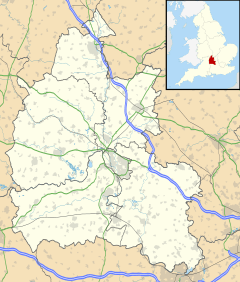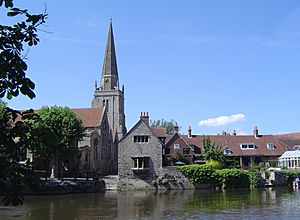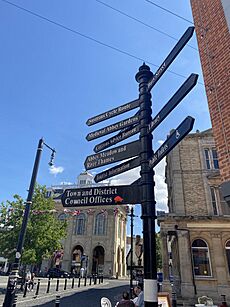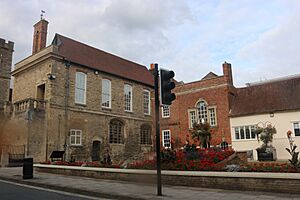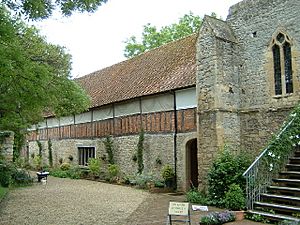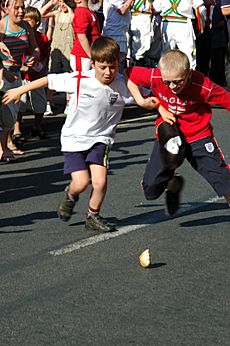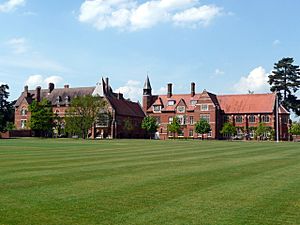Abingdon-on-Thames facts for kids
Quick facts for kids Abingdon-on-Thames
|
|
|---|---|
| Market town | |
 The River Thames at Abingdon looking towards St. Helen's parish church |
|
 Coat of arms of Abingdon: Vert a Cross patonce Or between four Crosses pattée Argent |
|
| Area | 9.09 km2 (3.51 sq mi) |
| Population | 37,931 (2021 census) |
| • Density | 4,173/km2 (10,810/sq mi) |
| OS grid reference | SU4997 |
| • London | 51.1 mi (82.2 km) |
| Civil parish |
|
| District | |
| Shire county | |
| Region | |
| Country | England |
| Sovereign state | United Kingdom |
| Post town | Abingdon |
| Postcode district | OX14 |
| Dialling code | 01235 |
| Police | Thames Valley |
| Fire | Oxfordshire |
| Ambulance | South Central |
| EU Parliament | South East England |
| UK Parliament |
|
| Website | Abingdon Town Council |
Abingdon-on-Thames (/ˈæbɪŋdən/ ab-ING-dən), often called Abingdon, is a very old market town in Oxfordshire, England. It sits right by the River Thames. Long ago, it was the main town of Berkshire county. People have lived here since the Iron Age, and a Roman fort was once under the town centre.
Abingdon Abbey was started around 676 AD, and the town got its name from it. In the 1200s and 1300s, Abingdon was a busy place for farming and trading wool. People also made clothes here. Kings like Edward I and George II gave permission for markets and fairs to be held in the town.
Even after the abbey was closed in 1538, Abingdon kept going. By the 1700s and 1800s, it became important for moving goods. This was thanks to the Abingdon Lock (built 1790) and the Wilts & Berks Canal (built 1810). In 1856, the Abingdon Railway opened, connecting the town to bigger train lines. The canal closed in 1906, but people are now trying to fix it up. The train station for passengers closed in 1963, but trains still carried goods until 1984. They served the MG car factory, which made cars from 1929 to 1980.
Morland Brewery, which made the famous Old Speckled Hen ale, was in Abingdon. It closed in 1999, and houses were built where it used to be. The famous rock band Radiohead started in 1985 when its members were students at Abingdon School. In 2021, about 37,931 people lived in Abingdon. The town's official name became "Abingdon-on-Thames" in 2012.
Contents
- Discovering Abingdon's Past
- Fun and Entertainment in Abingdon
- Sports in Abingdon
- Abingdon's Economy
- Getting Around Abingdon
- How Abingdon is Governed
- Places to Visit in Abingdon
- Abingdon's Traditions and Culture
- Famous People from Abingdon
- Schools in Abingdon
- Abingdon Around the World
- Freedom of the Town
- See also
Discovering Abingdon's Past
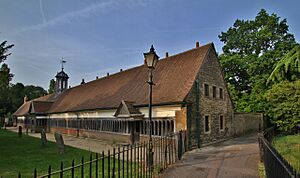
People have lived in Abingdon for a very long time. A stone hand axe from the Stone Age was found here. It came from the Lake District, about 250 miles away! Abingdon was also home to a large defensive area (called an oppidum) during the late Iron Age. This area was still used during the Roman times. In 1926, an even older site from around 3600 BC was found.
The Abingdon Abbey was founded in Saxon times, possibly around 676 AD. Its early stories are a bit mixed with legends. The name "Abingdon" might mean "Hill of a man named Æbba." But Abingdon is in a valley, not on a hill! So, the name might have first belonged to a place on Boars Hill and then moved with the Abbey. In 1084, William the Conqueror visited the Abbey. It's even thought his son, Henry I, might have gone to school there.
In the 1200s and 1300s, Abingdon was a busy farming town. It was famous for its wool trade and making clothes. The head of the Abbey held markets, and kings gave permission for more markets and fairs. In 1337, there was a big riot because people were unhappy with the Abbot's control of the market. Some monks were even killed. After the Abbey closed in 1538, the town became less important for a while.
In 1556, Queen Mary I helped Abingdon by making it a borough. This meant it could be governed by a mayor and other officials. The Christ's Hospital, which is an almshouse (a place for poor people to live), was started by Edward VI. It used to belong to a religious group.
Abingdon became the main town of Berkshire county after 1556. Important court cases were held here from 1570. The impressive County Hall and court house were built between 1678 and 1682 to show its importance. It was possibly designed by Christopher Kempster, who worked with Sir Christopher Wren.
In 1790, the Abingdon Lock was built on the Thames. Then, in 1810, the Wilts & Berks Canal opened. This connected Abingdon to other important places like Bristol and London. Abingdon became a key link for moving goods. In 1856, the Abingdon Railway opened, connecting the town to the main train line. However, Abingdon didn't fully join the railway boom. It only got a small branch line, which made Reading a more important town. Reading became the County Town in 1869.
The Wilts & Berks Canal was closed in 1906. But a group of volunteers is now working to fix it and open it again. The Abingdon train station for passengers closed in 1963. The line stayed open for goods until 1984, serving the MG car factory. The MG factory opened in 1929 and closed in 1980. Today, the closest train station is Radley, about 2 miles away. Much of the old railway line is now a cycle path.
In 1974, Abingdon's local government changed. It moved from Berkshire to Oxfordshire. The town became the home of the new Vale of White Horse District Council. Since the 1980s, many technology companies have moved to Abingdon. This has brought many young professionals to live in the town. In 2012, the town officially changed its name to "Abingdon-on-Thames."
Fun and Entertainment in Abingdon
Abingdon has great places for sports and fun, like the White Horse Leisure and Tennis Centre and Tilsley Park. The town used to have four cinemas, but they all closed. The last one, the Regal, closed in 1989. It was empty for years before being knocked down for houses. The Unicorn Theatre, located in the old Abbey buildings, shows plays and films sometimes. A new cinema, the Abbey Cinema, has also opened in a town council building.
Local newspapers include The Oxford Times, Oxford Mail, and Abingdon Herald. You can also listen to local radio stations like BBC Radio Oxford and Jack FM.
Abingdon has a large Tesco Extra supermarket. There's also the Fairacres Retail Park, which was one of the first shopping parks in the UK. It has stores like Argos and Pets at Home. In the town centre, you'll find many independent shops and charity stores. The town centre was updated in 2012, making it look more modern. The old Gaol (jail) building, which was a leisure centre, has been turned into fancy flats, shops, and restaurants by the river.
Sports in Abingdon
Abingdon has two non-League football teams: Abingdon United F.C. and Abingdon Town F.C.. The Oxford Saints American Football Club plays its games at Tilsley Park. They are one of the oldest American Football clubs in the UK, started in 1983.
Abingdon is also home to Abingdon Rowing Club. Its members range from 13 to 80 years old. They have won many local and national races. The club also holds its own Abingdon Head race in April, which is a big event in Abingdon. Abingdon Athletics Club trains at Tilsley Park.
Abingdon RUFC (Rugby Football Club) started in 1931. They now play at the Southern Sports Park. In 2022, the Abingdon Womens Rugby Club, called “The Albatrosses,” was formed. The Abingdon Sevens tournament, which started in 1956, kicks off the rugby season and attracts teams from all over the country. The club also has a Youth Section with 200 young players from ages 6 to 18.
Abingdon's Economy
In the past, the Pavlova and Gloria leather works were big employers in Abingdon, but they are now closed. Pavlova made different types of leather, like suede, for shoes, gloves, and belts.
Abingdon was also home to the Morland Brewery, famous for its Old Speckled Hen ale. This ale was named after an early MG car. Greene King Brewery bought Morland in 1999 and closed the brewery, moving production elsewhere. Houses were built on the brewery site. In 2010, a new craft brewery called Loose Cannon started brewing in the town again.
Abingdon is close to several big science companies. These include the UKAEA at Culham (which has the Joint European Torus (JET) fusion research project), Harwell Laboratory, and the Diamond Light Source synchrotron. Many people who live in Abingdon work in Oxford or travel to London by train from nearby Didcot. The Army now uses Dalton Barracks, which used to be an RAF station.
Abingdon has a business park with offices for many companies, including Sophos, an anti-virus company. RM, which supplies computers for schools, is also based nearby. Penlon Ltd, a medical equipment company, has its offices here. Another big employer is the British head office of the German appliance company Miele.
Abingdon was best known for the MG car factory, which opened in 1929. Over 1.1 million cars were made there in 51 years! The factory closed on October 24, 1980. The headquarters of the MG Car Club, started in 1930, is still in Abingdon. A police station was built where the factory used to be.
Getting Around Abingdon
Abingdon is about 9 miles south of Oxford. It's in the flat valley of the River Thames, where the smaller river Ock flows into it. The town is on the A415 road and close to the A34 main road, which connects it to the M4 and M40 motorways. Local bus services connect Abingdon to Oxford and nearby areas.
Abingdon no longer has its own train service. However, the Radley railway station is now very close to the town's edge. The small train stations at Culham and Radley are both just over 2 miles from the town centre. Much of the old Abingdon train line is now a path for walking and cycling. The closest major train stations with taxis are Oxford and Didcot Parkway.
How Abingdon is Governed
Abingdon has three levels of local government:
- Abingdon-on-Thames Town Council (for the town itself)
- Vale of White Horse District Council (for the wider district)
- Oxfordshire County Council (for the whole county)
The town council meets at the Guildhall on Bridge Street. Parts of the Guildhall are very old, dating back to the 1400s.
The town council has changed hands between the Liberal Democrats and Conservatives in recent years. Elections happen every four years. After the 2023 elections, the council was made up of:
| Party | Councillors | |
|---|---|---|
| Liberal Democrats | 18 | |
| Green | 1 | |
| Total | 19 | |
The current Member of Parliament for Oxford West and Abingdon is Layla Moran from the Liberal Democrat party.
Abingdon became a borough in 1556. This meant it had its own local government. In 1974, the borough was officially ended. Abingdon then became a civil parish with a town council. In 2012, the parish was officially renamed Abingdon-on-Thames.
Places to Visit in Abingdon
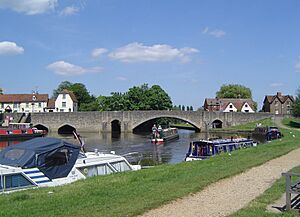
From the old Benedictine Abingdon Abbey, you can still see a gateway and parts of the old buildings. The Unicorn Theatre and the Long Gallery are still used for plays and events. St. Nicolas' Church, built in 1180, is near the museum. Abingdon Bridge over the Thames was built in 1416 and has been changed many times since. The Abbey Gateway is also an important local landmark.
Abingdon has the remains of an old motte-and-bailey castle. This was a type of fort built on a raised mound of earth. You can find it north of the town centre. There's also a Second World War pillbox (a small concrete fort) by the River Ock. A gaol (jail), built in 1811 by prisoners from the Napoleonic Wars, is on the south side of town by the Thames. It was turned into a leisure centre in the 1970s and then into flats and shops in 2011.
The Roysse Room was where Abingdon School was located from 1563 until it moved. The room is now part of the town offices. St. Helen's Church dates from around 1100. It's the second-widest church in England, with five aisles! The tower has ten new bells, put in place in 2006. Abingdon's county hall in the main market square, built in 1677–1680, stands on columns. This leaves the ground floor open for a market. It now holds the Abingdon County Hall Museum.
Abingdon's Traditions and Culture
Bun-throwing is a special Abingdon tradition! It started in 1761 for the Coronation of King George III. During this event, important local people throw buns (like sweet bread rolls) from the roof of the Abingdon County Hall Museum into crowds in the market square. This happens on special celebration days, like royal weddings or jubilees. The museum even has a collection of old, dried buns from past events! There have been 35 bun-throwing events so far.
Every October, the Abingdon Michaelmas Fair takes place. It's thought to be the longest and oldest street fair in Europe, stretching for a mile through the town. The fair used to be a "hiring fair," where farmworkers could find jobs after the Black Death in the 1300s. A smaller "Runaway Fair" happens the Monday after, for workers who wanted to find better jobs.
Abingdon has a very old and active Morris dancing tradition. Every year, a "Mayor of Ock Street" is chosen by the people of Ock Street. He then parades through town with the famous Horns of Ock Street, which are a symbol of Abingdon's Morris Dance group.
The Old Speckled Hen ale was first brewed in Abingdon by Morland's. It was made to celebrate the MG car factory in the town. The rock band Radiohead formed at Abingdon School in 1985.
Famous People from Abingdon
- See also Abbot of Abingdon, Abingdon School and List of Old Abingdonians.
- Ælfric of Abingdon, a 10th-century Archbishop of Canterbury
- Saint Edmund of Abingdon, a 13th-century Archbishop of Canterbury, was born here.
- Kate Garraway, a TV presenter, was born in Abingdon.
- David Mitchell, a famous actor and comedian, went to Abingdon School.
- Radiohead, the rock band, formed when they were students at Abingdon School.
- Dorothy Richardson, a novelist, was born in Abingdon.
- Matthew Taylor, a footballer, grew up in the town.
- Dean Whitehead, another footballer, was born in Abingdon.
- Kit Young, an actor, is from Abingdon and went to Abingdon School.
Schools in Abingdon
- Abingdon and Witney College: Offers further education courses.
- Abingdon School: An independent school for boys aged 11–18, with a prep school for younger boys.
- The Consortium: A group of local schools, including:
- Fitzharrys School
- Larkmead School
- John Mason School
- Europa School, UK (which replaced the European School, Culham).
- Our Lady's Abingdon: A private school for boys and girls aged 3–18.
- School of St Helen and St Katharine: A private school for girls aged 9–18.
Abingdon Around the World
Abingdon is connected to other towns in different countries. This is called "twinning." Abingdon is twinned with:
- Argentan, France
- Sint-Niklaas, Belgium
- Schongau, Germany
- Lucca, Italy
Freedom of the Town
The "Freedom of the Town" is a special honour given to people or military groups.
Military Units
- RAF Abingdon: Awarded in 1955.
- 12 Regiment, RLC: Awarded on 8 December 2010.
See also
 In Spanish: Abingdon-on-Thames para niños
In Spanish: Abingdon-on-Thames para niños


